
Figure 1
Activity I (Spring 2012): Folding a Rectangle - An Application of Alexandrov's Theorem
Prepared by:
Joseph Malkevitch
Department of Mathematics and Computer Studies
York College (CUNY)
Jamaica, New York
email:
malkevitch@york.cuny.edu
web page:
http://york.cuny.edu/~malk
Start with a rectangular piece (Figure 1) of paper (8.5x11 will do fine).

1. Locate a point A* 1/4 of the way from A to B (Figure 1) and a point C* 1/4 of the way from C to D without using a ruler.
2. What is the (Euclidean) distance (as the "crow" flies) between A* and C*?
3. i. What is the distance between A* and C* as measured along the ""route:"
a. A*ADC*
b. C*CBA*
ii. Does it seem reasonable to call the segment A*C* a perimeter bisector for the rectangle?
iii. Is A*C* an area bisector?
iv. What are the perimeter bisectors for this rectangle?
v. What are the area bisectors for this rectangle?
vi. Is there a line which bisects the area for any point in the interior of the rectangle?
vii. Is there a line which bisects the perimeter for any point in the interior of the rectangle?
4. Can you think of a way other than Euclidean distance and what was done in 3. to find the distance between A* and C*?
5. Consider the rectangle in Figure 2 where A* is a quarter of the way from A to B and C* is a quarter of the way from C to D.

a. What shape do you get if you paste the boundary in Figure 2 along the "route" A*ADC* to the route A*BCC? Use transparent adhesive tape "scotch tape" to paste the boundary of the rectangle's boundary to itself. It is as if we "zipped up" the rectangle's boundary from A* to C* along the two different boundary routes between them. Call the shape you get P.
b. What shape do you get when you paste the boundary of the rectangle with tape so that A* is pasted to C* and you continue to paste the remaining boundary together? The idea is to start as if you were going to identify A to D and B to C to get a cylinder but you "shift" the paper so that A* and C* match up. When this is done, instead of getting two circular holes at the end of the cylinder as when A and D and B and C are pasted, you get two "irregular shaped" holes, one at each end of the surface at this stage. Now you continue to use the transparent tape to identify the boundary of the first hole to itself and the second hole to itself. It is easier to DO than it is to describe what is involved! Call the shape you get P'.
c. Are the shapes you get from these two different ways to paste the rectangle's boundary to itself (e.g. P and P') the same?
d. What is the surface area of P?
e. What is the surface area of P'?
f. What is the volume of P?
g. What is the volume of P'?
Note: Some of the questions above are not necessarily easy to answer! Part of the point here is how easy it is to do something simple which leads to hard ideas. For geometrical problems it is common to reach unsolved problems quite quickly.
References:
Alexander, R. and H. Dyson, J. O'Rourke, The Convex Polyhedra Foldable from a Square, In Proceedings of the Japan Conference on Discrete and Computational Geometry, Lecture Notes in Computer Science, Vol. 2866, 2003, Springer, New York, pp. 36-50.
Demaine, E. and J. O'Rourke, Geometric Folding Algorithms, Cambridge U. Press, New York, 2007.
O'Rourke, J., Folding Polygons to Convex Polyhedra, in Understanding Geometry for a Changing World, (ed.) T. Craine and R. Rubenstein, NCTM 71 St. Yearbook, NCTM, Reston, 2009, pp. 77-87.
O'Rourke, J., How To Fold It, The Mathematics of Linkages, Origami and Polyhedra, Cambridge U. Press, New York, 2011.